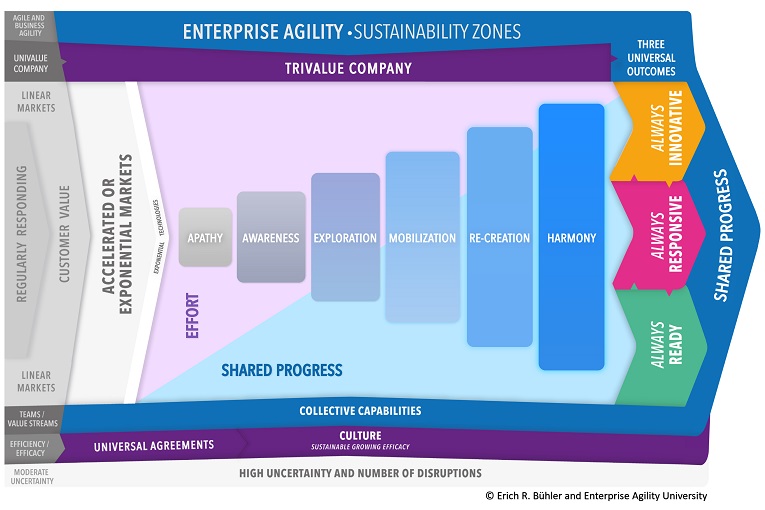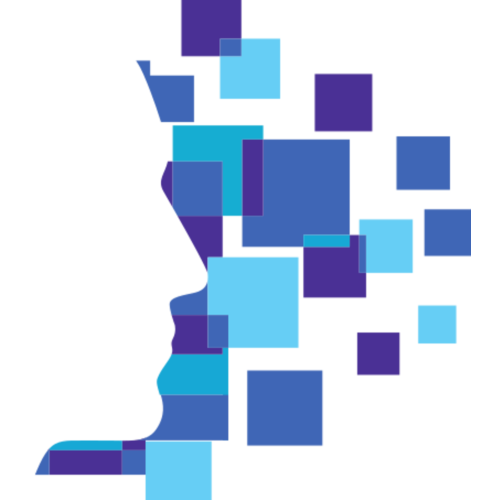The Sustainability Zones were created for change leaders trying to improve the organization. But how can Product Owners (POs) apply them to evolve their organization and prepare their products for disruption? We've written this guide on using the Zones specifically for them!

You already know that in today's fast-paced business environment, dealing with constant change is an inevitable part of your job. Markets transform rapidly, technologies disrupt, and customer needs evolve—requiring product owners to continually adapt products, practices and priorities to keep pace.
While change brings opportunities, it also introduces complexities that can be difficult to deal with. Adopting the Sustainability Zones model from Enterprise Agility provides a robust framework for strengthening abilities individually and across teams to thrive amidst uncertainty.
The Sustainability Zones
This model identifies six zones that indicate an organization's level of flexibility and readiness for accelerated markets and disruption. This also means quickly adapting your products to a new situation.

As a product owner guiding their products through market shifts, understanding current strengths and gaps using this framework enables more proactive planning.
- Apathy zone: Companies see that familiar approaches persist, and change is incremental. Sustainability depends on stability, not adaptability. Limited visibility into external dynamics or emerging opportunities (Not sustainable).
- Awareness zone: Organizations see that awarenessgrows of the need for new mindsets and skills to navigate increasing complexity. Curiosity emerges around new practices enabling agility and shared progress. Initial experimentation begins (Initial sustainability).
- Exploration zone: Businesses see that commitment to building new capabilities for Enterprise Agility expands through discovery and partnerships. While outcomes remain uncertain, learning from early wins fuels motivation to continue the journey (Emerging sustainability).
- Mobilization zone: Companies see that skills develop, and interdependence starts optimizing through shared priorities and measures of success. Gaining momentum, groups powerfully reimagine ways of working together for mutual benefit (Progressing sustainability).
- Re-creation zone: Organizations see that with vision and capabilities for flexibility to accelerated change now getting strong, they can continuously recreate offers, partnerships, and business models to navigate change. Groups thrive on openness to human potential and mutual gains (Advancing sustainability).
- Harmony: Businesses have deeply ingrained skills for sensing, mobilizing, and innovating to empower readiness, responsiveness, and adaptation across global contexts. Collective creativity is optimized through shared purpose and understanding of interdependence. Recreating the business model is the new normal (Optimized sustainability).
The Sustainability Zones provide an important framework for you even though they assess organizational agility because product development does not happen in isolation. The ability of product owners to drive successful outcomes ultimately depends on the broader capabilities and alignment across their company. Some key reasons the Sustainability Zones offer value to product owners:
- Cross-Team Collaboration - Reaching higher zones requires coordination across multiple teams—engineering, sales, support, etc. Product owners need visibility into these collective capabilities as cross-functional collaborators to identify dependencies and risks.
- Executive Buy-In - Progressing across zones involves evolving strategies, structures and investments. Product owners must influence executives to secure backing and resources. Understanding organizational maturity levels enables tailored messaging.
- Org-Level Constraints - Development velocity and product success hinge on people, processes and technology. Organizational limitations surface urgent areas for improvement that product owners can champion.
- Holistic Insights - Zone assessment provides a big-picture view of enablers and blockers for agility, allowing product owners to spot crucial gaps impeding performance. This guides systemic solutions.
- Sprint Planning - By factoring in organizational strengths and weaknesses identified through the zones, product owners can better scope sprints and plan iterative enhancements to build team capabilities within project work.
- Talent Development - The zones highlight important skills for thriving amid change that product owners can instill within team members through coaching and growth opportunities.
While product development occurs at the team or value-stream level, it relies on organizational-wide structures, strategies and culture. Assessing where the company falls on the Sustainability Zones scale equips product owners with crucial insights into these broader dynamics shaping their path. This allows you to pinpoint systemic obstacles, demonstrate urgency for change, and gain leadership support—empowering them to scale product excellence.
Assessing Readiness
Product owners who want to gauge their agility may find their team lacks adequate data, skills, or processes to sense and respond to market shifts (Zone 2). Or perhaps experiments are happening but without alignment on vision (Zone 3).
Determining factors preventing progression to higher levels enables targeted action. Does the organizational structure hinder fast product iterations? Are teams empowered to drive ideas through to execution? Do legacy systems limit ability to capture customer insights?
Once gaps are identified, you can make a case to senior leaders for investments in capabilities needed to reach the next zone. This clarity also allows planning iterations and backlogs to incorporate activities that incrementally improve agility.
Influencing Progress
Beyond assessments, as ongoing advocates for the customers within their organizations, you play an integral role in influencing movement across the zones. You can encourage experimentation by allowing time in sprints for the exploration of potential new features, innovations or enhancements. Supporting autonomy empowers teams to self-organize and push boundaries. You also ensure user needs are represented in discussions to evolve workplace practices or restructure teams and processes. Customer insights help make the case for change. By regularly reflecting on product success and team operations using the Sustainability Zones model, you can guide continuous capability building over time.
Scaling Your Products with the Sustainability Zones
As the adoption and usage of a product expands, scaling becomes imperative but intensely complex. The Sustainability Zones provide a model for product owners to evaluate and develop the capabilities that enable successful scaling. Before actively pursuing rapid scaling, product owners should conduct an honest appraisal of organizational readiness across factors like:
- Infrastructure - Can systems handle increased load and traffic? Are cloud services leveraged for flexibility?
- Support - Is customer service adequately staffed and trained to handle inquiries at 10x the volume?
- Quality - Are automated testing, monitoring and reliability practices sufficient to prevent outages?
- Finances - Does the pricing strategy still work at higher scales? Are budgets set for marketing?
By examining preparedness through the lens of the Sustainability Zones, you gain insight into priority gaps to address in advance of scaling efforts.
Driving Progress
Once areas for improvement are identified, product owners play a key role in driving development of organizational capabilities needed for scale. For example, if assessment reveals potential infrastructure limitations at volume (Zone 2), the product owner can work with engineering leaders to right-size cloud resources and build auto-scaling functionality into the product architecture to support elastic capacity (Zone 3).
If the evaluation shows the need for more automated and streamlined processes for software delivery and testing (Zone 3), the product owner can spearhead cross-functional efforts to implement CI/CD pipelines, test automation and infrastructure as code (Zone 4).
Securing Buy-In
Gaining stakeholder alignment on scaling initiatives requires communicating urgency in the best possible way and with a language that they understand. You can point to assessment findings from the Sustainability Zones to demonstrate gaps that pose risks, and make a compelling case for 'must fund' priorities to address these deficits before moving forward.
By taking an organization-wide view based on the Sustainability Zones, you, as a product owner, can gain crucial insights to set up initiatives for success in navigating scale. They can then leverage these insights to secure the executive support and resourcing needed to meet the challenges ahead.
Mastering Complexity
As the complexity of business surges, you have a central role in evolving ways of working, mindsets, and systems to thrive in times of exponential change. With the Sustainability Zones framework, you gain a simple yet powerful tool to evaluate and strengthen organizational agility—enabling teams to not just survive, but master, sustainability to be able to deal with complexity.
Shared Progress
As you have seen, the Sustainability Zones demonstrate how organizations progress on their flexibility and resilience journey when capabilities across multiple dimensions mutually reinforce each other. This is directly aligned with the idea of Shared progress in Enterprise Agility.
For product owners like you, pursuing shared progress means focusing less on isolated metrics and more on strengthening the interdependent dimensions that enable teams to thrive amid uncertainty. The are capabilities assessed and developed through progression across the Sustainability Zones.
For example, a product owner may use the Zones to identify their organization currently lacks adequate feedback loops, learning forums and experimentation (Zone 3). These gaps inhibit continuous learning and workforce empowerment.
By taking steps to establish reflection rituals, enable prototyping and upskill employees, the capabilities for shared progress expand. As this occurs across dimensions, the overall organization advances towards Zone 4.
In this way, the dimensions of Shared progress form the core muscles organizations must build to progress through the Sustainability Zones. By internalizing a shared progress mindset, everyone can assess maturity, identify priority capability gaps, and take targeted actions via roadmaps and team initiatives to incrementally strengthen these interconnected dimensions.
Remember that focusing solely on delivery metrics risks stagnation. But pursuing shared progress builds resilient teams and organizations. The Sustainability Zones give product owners a roadmap for weaving shared progress into the fabric of how their products are envisioned, built and scaled.
Do you want to know more about Sustainability Zones? Check out Enterprise Agility Fundamentals Chapter 16.
